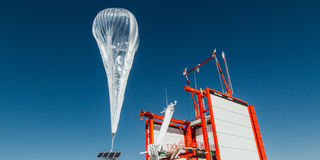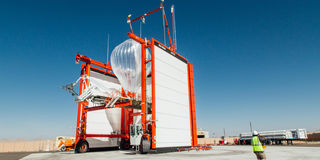Loon begins grounding internet balloons in Kenya

Loon, Alphabet’s project intended to bridge the digital divide by beaming high-speed internet to remote parts of the world using floating cell towers, has wound its operations in Kenya.
Loon, Alphabet’s project intended to bridge the digital divide by beaming high-speed internet to remote parts of the world using floating cell towers, has wound its operations in Kenya.
The company, which is owned by Google’s parent firm, Alphabet, announced Monday that it has stopped providing internet services in the country and that it is in the process of grounding its internet balloons.
“A few weeks ago, we announced that Loon would begin to wind down its operations over the coming months. As part of that, today marks our last day of providing service in Kenya,” wrote Loon on a blog post on Monday.
No commercial viability
The pilot project, carried out in partnership with Telkom Kenya, had announced in January, that it would be shutting down the project, citing lack of commercial viability.
“While we’ve found a number of willing partners along the way, we haven’t found a way to get the costs low enough to build a long-term, sustainable business,” Loon CEO Alastair Westgarth wrote in a blog post in January.
Loon, the nearly decade-old company, was given the formal approval to have its balloons operate in Kenya in March 2020.

A Loon balloon
During the official announcement of the project by President Uhuru Kenyatta, the Head of State praised Google Loon Services, adding that it was in line with the government’s measures to respond to disruptions caused by the Covid-19 pandemic that has seen many people work from home to avoid contracting the respiratory illness.
“In that regard, and to foster communication and enable Kenyans to retain and enhance remote access to the offices and enterprises, my administration has granted approvals that will ensure universal 4G data coverage throughout Kenya,” said the President when he briefed the journalists at State House, Nairobi.
According to Loon, the balloons will be grounded over the coming months.
“We’ve begun safely returning the fleet of balloons to the ground, a process we expect to take a number of months. We’re incredibly thankful to our partner, Telkom Kenya, as well as the government and people of Kenya for so warmly welcoming us over these past years,” the company wrote.

According to Loon, the balloons will be grounded over the coming months.
Telkom Kenya announced during the launch of the service that it would initially cover a region spanning nearly 50,000 square kilometres, including the areas of Iten, Eldoret, Baringo, Nakuru, Kakamega, Kisumu, Kisii, Bomet, Kericho, and Narok.
In terms of data transfer rate, one of the field testing sessions reported by Loon and Telkom Kenya in late June 2020 registered an uplink (upload) speed of 4.74 mbps, a downlink (download) speed of 18.9 mbps, and latency of 19 milliseconds.
20km above ground
Loon’s balloons flew on the stratosphere layer of the atmosphere, “high above where commercial jets fly, but much lower than satellites.” According to Loon, that is 20 kilometres above the ground, an area the company says despite having harsh conditions, is a connectivity sweet spot since it is “so high that one flight system can cover an area 200x greater than an average cell tower.”
This according to Telkom Kenya, enabled Loon to provide services to traditionally hard-to-reach or underserved areas.
The balloons (floating base stations) were linked to the ground stations connected to Telkom Kenya’s network. From there, a signal could be sent across multiple balloons, creating a network of floating base stations that would serve a wide coverage area, delivering connectivity directly to a user’s LTE-enabled device, below.
In a statement, Telkom Kenya CEO Mugo Kibati said the company would continue to undertake its long-term terrestrial network expansion to keep customers connected.

Loon’s balloons flew on the stratosphere layer of the atmosphere, “high above where commercial jets fly, but much lower than satellites.”
“Telkom remains cognisant of the integral role our core terrestrial network plays in keeping our customers connected. We continue with our long-term terrestrial network expansion plan, that is informed by our overall company strategy, which will see us scale up to 80 per cent of our network to 4G, increase our network footprint across the country, and get more Kenyans online,” said Mr Kibati.





